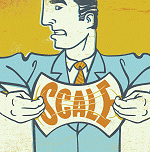Scale
##AUTHORSPLIT##<--->
Growing your innovative programs isn't just
about adding more users. A new framework
requires educators to stretch old notions of
what scaling is and how it can be successful.
 YOU'VE PROBABLY SEEN IT
happen in your own school district. Somebody
comes up with a great idea that has
a dramatic impact on student success, and
suddenly other teachers, other grades, other
schools want to adopt it too. It could be a new
game for engaging kids in math, or a video
podcasting project for reading and writing. Maybe it's a
new way to teach teachers how to integrate technology into
their lessons. Yet, when that idea is transferred to a new environment--
a different classroom or school-- it doesn't produce the same success.
That's the challenge inherent in scaling.
YOU'VE PROBABLY SEEN IT
happen in your own school district. Somebody
comes up with a great idea that has
a dramatic impact on student success, and
suddenly other teachers, other grades, other
schools want to adopt it too. It could be a new
game for engaging kids in math, or a video
podcasting project for reading and writing. Maybe it's a
new way to teach teachers how to integrate technology into
their lessons. Yet, when that idea is transferred to a new environment--
a different classroom or school-- it doesn't produce the same success.
That's the challenge inherent in scaling.
And it's a challenge that poses more trouble for education than it does for other
fields, according to Christopher Dede, a professor of learning technologies at the
Harvard Graduate School of Education.
The difference between education and other industries is that "every educational situation
is different in a way that is more profound than every fast-food restaurant being
different," says Dede, who is co-editor of the 2005 book Scaling Up Success: Lessons
Learned From Technology-Based Educational Improvement (Jossey-Bass). "If there's a
new way to fry French fries, you can adopt it at a whole variety of fast-food places. But
in education, the range of variation is much higher." Those variations include such factors
as how the teacher prepares content, what pedagogical style is used, and even
classroom or school culture.
The common approach to scaling, says Dede, is to jump in and say, "Let's go out and
find more money, recruit more participants, hire more people. Let's just keep doing the
same thing, bigger and bigger." That, he observes, "tends to fail, and fail badly." Dede
says some innovations just aren't built for appropriating by other institutions. "There are
many, many programs out there that are of high quality, [but] there are very few that
operate at scale, that aren't just a little hothouse program that only affect a few people--
and really are incapable of doing more than that."
"The real measure of whether something has scaled is basically
whether it scales. It's not whether it follows the [five] dimensions.
It's whether it manages to have a huge impact."
Got Scale?
Finding the most effective way to transfer a successful program
to other environments is the aim of a current research
project sponsored by Microsoft that focuses specifically on
how to apply technology to scaling education innovations.
The project is an outgrowth of the company's US Partners
in Learning (PIL) program, begun in 2003 as a five-year, $250
million global project to build public/private partnerships for
the purpose of meeting three goals: universal digital literacy, a
stronger workforce, and improved quality of life. Because of its
success, the program was re-upped for another five years in 2008.
In 2005, to learn more about what it takes to scale up successful
educational initiatives, the PIL team dedicated a portion of its
funding to a select group of organizations that had programs it
deemed ready to be scaled through the use of technology.
Allyson Knox, Microsoft's academic program manager,
brought Dede, a former graduate professor of hers at Harvard,
in to work as a consultant with initiatives chosen for what was
named the Mid-Tier Project.
As grant manager for PIL, Knox got used to hearing the
same pitch from applicants: "I have this great program, I want
to write a grant proposal, and I'm going to prove that I can
scale or replicate this to x number of programs throughout the
US." Then, they would submit plans, she says, that would be
focused strictly on replication numbers: If we get five teachers
trained in this, then each of them can train five more teachers,
and that's how we'll grow this thing! Fixating on numbers is
the wrong approach, Knox says, because you have to factor in
steps that must be taken to address the different circumstances
and challenges faced by users in different environments. Simply
equating scaling with multiplying is a mistake.
Dede and Knox saw the need to educate grantees on the
concept of scaling. As part of that effort, the team adopted,
adapted, and began disseminating a framework first put forth
in research published by Cynthia Coburn (see Links),
an assistant professor at the University of California-Berkeley
Graduate School of Education. Coburn proposed a definition
of scale that went beyond growth in numbers to include depth,
sustainability, spread, and shift. Dede and Knox, along with
research consultant Saul Rockman, president of the San Francisco-
based consultancy Rockman Et Al, added a fifth aspect
to the framework: evolution (see "Redefining Scaling").
"Often, the first way people measure scale comes back to
the number of students or teachers who have been trained,"
Knox says. "They don't look at all five dimensions, which
would help them achieve greater impact and scale."
That isn't to say that trying to scale a project will necessarily
fail if all five dimensions aren't considered. "The real measure
of whether something has scaled is basically whether it
scales," Dede says. "It's not whether it follows the dimensions.
It's whether it manages to have a huge impact."
Redefining Scaling
 The usual way to think about scaling a program is to consider how it
can be expanded to reach more people. However, that may actually
inhibit the program's potential to continue to work effectively. Harvard
University's Christopher Dede and Microsoft's
Allyson Knox have found that scaling encompasses five dimensions.
The usual way to think about scaling a program is to consider how it
can be expanded to reach more people. However, that may actually
inhibit the program's potential to continue to work effectively. Harvard
University's Christopher Dede and Microsoft's
Allyson Knox have found that scaling encompasses five dimensions.
SPREAD: Diffusion of the innovation to a large number of users;
the traditional way of thinking about scale.
DEPTH: Producing deep, transformative, consequential changes
in instructional practice, leading to improved educational
outcomes for students.
SUSTAINABILITY: Maintaining changes in practice over a
substantial period.
SHIFT: What happens when districts, schools, and
teachers assume ownership of the innovation and
spread its impact.
EVOLUTION: The ongoing revision of the innovation by those adapting it.
Spread and Depth
One program whose grant application won support from PIL
was the Teacher Leadership Project (TLP), a professional development
program launched by Northwest Educational Service
District (NWESD) 189, one of nine educational service districts
in the state of Washington that provide administrative and
instructional support services to districts and schools.
TLP grew out of an initiative begun in 1997, when NWESD,
using a modest grant from what was then the William H. Gates
Foundation, pulled together a group of 27 teachers statewide for
a special week of summer training that would show them how
to integrate new types of technology into student-centered
learning, with a heavy emphasis on using the technology in
support of collaborative, project-based exercises. After the week
was up, participants continued getting together every couple of
months to maintain the learning, sharing, and collaborating. That initial undertaking led NWESD to create the Teacher
Leadership Project, and those original participants became
trainers themselves, training 150 teachers in the same collaborative
lessons during the summer of 1998 and another 250 in
1999. By 2000, NWESD was confident
enough in the program to appeal for
a larger grant. The Bill & Melinda
Gates Foundation, renamed that same
year after absorbing the William H.
Gates Foundation and the Gates Learning
Foundation, came forward with $45
million to support a major expansion:
training 1,000 teachers a year for three
years throughout Washington.
Scaling up the program involved hiring "a lot of people" and
managing "a lot of logistics around organizing"-- in other
words, doing more, more, more-- according to Becky Firth,
who as director of NWESD's Technology Leadership Center
oversees the Teacher Leadership Project. Firth, a former English
teacher, was one of the original 27 educators chosen by NWESD
when it launched the project in 1997. To reach teachers
statewide, TLP ran four consecutive weeks of training in nine
different locations each summer. Following the workshop, the
same participants were brought together three more times
during the year for Friday/Saturday sessions, with the cost of
substitutes covered by the grant money.
By the time the funding had run its course, 3,000 teachers in the
state had gone through the training. "A Decade of Reform: A
Summary of Research Findings in Classroom, School, and
District Effectiveness in Washington State," a 2003 report
from the Washington School Research Center at Seattle Pacific
University, hailed the program, stating, "Evaluation results have
shown that many participants have changed their classroom
instruction, sometimes substantially."
Firth says that TLP's success prompted districts in other
states to begin contracting with TLP to
provide training for their staffs. But one
factor made the arrangement untenable:
Flying instructors across the country
four times a year to conduct training
was too costly. "We knew financially it
wasn't going to work," Firth says.
The program needed to explore a
different way to scale in order to reach
educators outside of Washington. The
solution: Add an online component.
This desire to use the web as a scaling tool won over
Microsoft's Mid-Tier Project, which stepped up with
$426,000 in funding to help TLP develop a hybrid program.
The transition, however, from a wholly face-to-face model
would require focusing on additional dimensions of scaling,
on top of the traditional notion of spread: Depth and evolution
would also come into play.
To ensure depth-- meaning the kind of profound changes
in instructional practice that lead to improved educational outcomes
for students-- Firth tapped the expertise of teachers who
had been through the program and gone on to become trainers.
The consensus: The face-to-face summer workshops had to stay.
"That puts everyone on the same footing," Firth says. "Everyone
has the same experience."
The initial workshops were retained, but the follow-up
two-day sessions were moved online. Plus, a new web-based
portal was developed where teachers could maintain and
add to lesson plans they were developing in the program,
share them with other teachers, and exchange feedback. To
prevent dropouts, the program added online mentors to check
in on participants.
Under the hybrid format, Firth says, TLP has been able
to conduct face-to-face workshops in several states, including
Wisconsin, Tennessee, Texas, Florida, Minnesota, and New
York, but any further expansion of the program will have to
wait. "I'd love to see thousands of teachers trained across the
country every year," she says. "But we're thinking small-scale
right now, maybe 100."
With the online portion of the training program successfully
developed, TLP is now creating standalone training modules to
add to its online content. That's an example of evolution in
scaling-- rethinking core beliefs about the innovation.
The biggest question for Firth is whether this new hybrid
model will ensure the final scaling dimension: sustainability--
maintaining changes over a long period. That's because
significant changes to classroom instruction "aren't going to
happen in a year; it's going to take two or three years," she says.
"Our one year [of training] is still better than the typical three or
four days of professional development a teacher gets. But it takes
time to see that overall change in the classroom."
A Sixth Dimension: Emotion
 Introducing new ways of working can be
challenging when scaling a project. "People
are eager to change when they feel they're
struggling," says Harvard University professor
of learning technologies Christopher Dede. "When they feel
they're operating at a very high level of quality, it's much harder
emotionally to say, 'To have a big footprint, I have to do things differently,
even though it seems risky to me to move away from my
perfect method of operating.'"
Introducing new ways of working can be
challenging when scaling a project. "People
are eager to change when they feel they're
struggling," says Harvard University professor
of learning technologies Christopher Dede. "When they feel
they're operating at a very high level of quality, it's much harder
emotionally to say, 'To have a big footprint, I have to do things differently,
even though it seems risky to me to move away from my
perfect method of operating.'"
In fact, he adds, that was one of the biggest surprises for him: the
emotional dimension of scale. "Asking people to take something that
was highly successful and modify it-- that's often the hardest thing for
a person or organization to do."
Shift and Evolution
A second professional development
initiative supported by the Mid-Tier
Project provides an example of how
scaling can be less about spread than it is about shift and evolution--
adapting what you already have. The initiative, the 21st
Century Learning Project, was developed by the Alabama
Best Practices Center. The center already provides professional
development through a program called Powerful Conversations.
Four times a year, educators meet to share ideas on improving
teaching and learning in the state. But, according to the center's
executive vice president, Cathy Gassenheimer, there was a sense
that Alabama educators needed to learn more about how to use
Web 2.0 collaboration tools in the classroom. "Students outside
school have so many tools," she says. "Unless they're able
to use them in school, we're going to lose them."
Not wanting to pull teachers out of school any more than it
already was doing for Powerful Conversations' quarterly events,
the center explored digital alternatives. With $426,000 in funding
from the Mid-Tier Project, the center launched the 21st
Century Learning Project in 2005, recruiting 20 schools to
participate in a virtual learning community built around an online
curriculum called "Keeping up With the Net Generation." Each
school was allowed five participants, of which at least one had to
be a principal, an assistant principal, or an instructional leader.
During the project's first year, four teams at a time met online
after school for two-hour webinars, using the collaboration tool
Elluminate Live! to hear presentations and have discussions.
Follow-up was done via Tapped In, an online learning community
of education professionals, as well as through in-person
quarterly meetings. Also, the center selected 10 "fellows" to
receive extra training in order to coach in schools.
By 2007, the Microsoft grant had expired and schools needed
to self-finance their participation. The tab came to $7,500
apiece. Participants were cut from 20 schools to 10, because,
Gassenheimer explains, "we wanted to make sure we could
provide them with a whole lot of support."
But in 2008, the project received a $150,000 grant from the
state, which meant schools would not have to pay their own way.
In fact, each school got $2,500 from that fund to apply to
expenses related to professional development. Plus, schools
would no longer be limited to five participants; seats for each
after-school webinar became first come, first served. Meanwhile,
the project is now recording its sessions and posting them on a
wiki for broader consumption. The subjects covered are becoming
more topical, not just explaining the basics of Web 2.0. This
year, says Gassenheimer, participants are learning "how to
'21st-centurize' math and science lessons at elementary levels."
TO READ Christopher Dede
and Allyson Knox's report, "Using
Technology to Scale Up Innovations,"
which examines the scaling of the
two professional development programs
described in this article, visit
here.
Scaling the 21st Century Learning Project has required
frequent tweaking. A year after the 2005 launch, the idea of the
fellows was dropped. "What we didn't calculate is, if you're
teaching full time, it's hard to have time not only to coach your
peers, but also to provide support to other schools," Gassenheimer
explains. Plus, the program now kicks off with a face-to-face
meeting, and the Tapped In service has been replaced by an
invitation-only wiki site on the
social networking service Ning.
The project continues to evolve
as it is adapted by school districts.
One participant, Talladega County Schools, added a tiered
mentoring system, school visits by mentors, and "Friday Five,"
a weekly e-mailed newsletter with advice and tips. "When they
called to see if we'd mind if they use our materials, we said, 'No,
please, use it-- and let us learn how you're using it," says
Gassenheimer. Now the center is bringing some of Talledega's
ideas into its version of the training.
What the Mid-Tier Project has done through its support for
the 21st Century Learning Project and the Teacher Leadership
Project is show the importance of a multidimensional scaling
framework when considering how to expand an innovation in
education. "It's crucial [for] reflecting on ways not just to do the
same things bigger and bigger, but to do something that's
related to what you're doing but still different in some important
ways," Dede says. "The framework is saying, 'It's more complicated
than you think it is.' Stepping back and recognizing that
complexity is a really important first step."
::WEBEXTRAS ::
If you would like more information on scaling
technology initiatives, please visit our website at
www.thejournal.com. Enter the keyword scaling.
Dian Schaffhauser is a freelance writer based in Nevada City, CA.